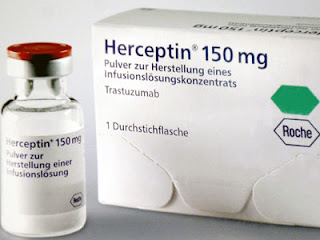Links may be found on the treatment pages of our LATESTBreastCancer.com website.
Omnitarg for HER2 positive metastatic breast cancer
The phase III Omnitarg (pertuzumab) study, known as CLEOPATRA (CLinical Evaluation Of Pertuzumab and TRAstuzumab), was big news. Reuters, Medical News Today, The New York Times and Los Angeles Times all ran stories. The study was published in the New England Journal of Medicine on December 7. (Link to full text.)
In the study, 808 women with HER2 positive metastatic breast cancer were randomly assigned to receive Herceptin (trastuzumab) and Taxotere (docetaxel) either with or without Omnitarg.
For the Omnitarg group, median progression-free survival, meaning the amount of time the cancer remains stable, was 18.5 months compared to 12.4 months for the Herceptin/Taxotere only group.
Although it's too early to confirm overall survival data, preliminary results show 69 deaths among the 402 women treated with Omnitarg compared to 96 deaths among the 406 women who did not receive Omnitarg.
Genentech and its parent company, Roche, have applied for permission to market Omnitarg in the US and Europe as first-line treatment for HER2 positive metastatic breast cancer.
Avastin for HER2 positive metastatic breast cancer
After the recent FDA decision to pull approval of Avastin for metastatic patients, there has been interest in identifying subsets of patients who may benefit from Avastin.
The phase III study (AVEREL) of Avastin (bevacizumab) in HER2 positive metastatic patients was similar in design to the Omnitarg study. 208 women were treated with Herceptin and Taxotere alone. 216 also received Avastin. The New York Times, Los Angeles Times and US News and World Report/HealthDay covered the study.
For the Avastin group, progression-free survival was 16.5 months, compared to 13.7 months for the 208 in the Herceptin/Taxotere only group.
But some question whether small benefits in progression-free survival are important.
According to the New York Times, "there was absolutely no difference in how long the women lived." Genentech has decided not to apply for FDA approval for HER2 positive breast cancer. A company representative noted, "Our bottom line is we do not believe that the difference in P.F.S. is of a sufficient magnitude that it is likely to gain regulatory approval."
Future research will attempt to identify the subset of patients who benefit from Avastin. As Dr. Gabriel Hortobagyi from MD Anderson noted in Los Angeles Times,
"I have no doubt that Avastin is a very powerful drug for some patients. . . The problem with Avastin is we don’t have a biomarker to help us identify the sub-group."Afinitor for hormone-receptor positive metastatic breast cancer
A study (BOLERO-2) of Afinitor (everolimus) involving 704 women with hormone-receptor positive breast cancer which progressed on prior hormone therapy was covered by The New York Times, Los Angeles Times and Medical News Today. The study was published in The New England Journal of Medicine on December 7. (Link to full text.)
For women who took Afinitor plus the aromatase inhibitor Aromasin (exemestane), median progression-free survival was 7.4 months, compared to 3.2 months for women who took Aromasin alone.
However, the New York Times (Dec. 7) noted that because all women had already failed to benefit from hormone therapy, "perhaps it is not surprising that the control arm did not do that well on exemestane alone."
But, the trial researchers said that doctors often prescribe Aromasin in practice when other hormone therapies fail.
Medical News Today quoted Dr. Hortobagyi, a study coauthor, to say, "These findings may establish a new standard of care for advanced breast cancer."
Faslodex for hormone-receptor positive metastatic breast cancer
A phase III trial (SWOG S0226) of Faslodex (fulvestrant) plus Arimidex (anastrozole) for women with hormone-receptor positive metastatic breast cancer was covered by the Medical News Today on December 9.
In the study, 707 postmenopausal women were assigned to receive Arimidex plus Faslodex or Arimidex alone. Compared to the Arimidex alone arm, the Faslodex arm experienced longer median overall survival (47.7 months vs. 41.3 months) and longer progression-free survival (15 months vs. 13.5 months).
Both Arimidex and Faslodex are already used to treat breast cancer, though not in comination. The lead study coordinator noted that "these patients have not had a new treatment that gave them an overall survival benefit in more than a decade."
Entinostat for hormone-receptor positive metastatic breast cancer
A small phase II study (ENCORE 301) of entinostat for locally recurrent or metatstatic breast cancer was covered in a PR Newswire press release and the New York Times (Dec. 7)
In the study, 130 patients were treated with Aromasin (exemestane) alone or Aromasin plus entinostat. The median overall survival for the entinostat group was 26.9 months, compared to 19.8 months in the Aromasin alone group. Progression-free survival was also better with entinostat (4.3 months vs. 2.3 months.)
A randomized phase III study is anticipated to begin enrollment in the first half of 2012.
Abraxane as first-line treatment for metastatic breast cancer
A phase II study comparing Abraxane (nab-paclitaxel) to Taxotere (docetaxel) as first-line therapy for metastatic breast cancer was covered by Medical News Today on December 12.
In the study, 300 women who received no prior chemotherapy for metastatic disease were divided into four groups. Three groups received different doses of Abraxane. The fourth group received Taxotere.
The best median overall survival was achieved by the group that received 150 mg of Abraxane twice weekly (33.8 months.) The other two Abraxane dose schedules achieved median overall survival of 22.2 months and 27.7 months. For the Taxotere group, median overall survival was 26.6 months.
Progression-free survival was also better for the Abraxane 150mg/twice weekly group at 14.6 months, compared to 7.5 months and 10.9 months for the other Abraxane doses and 7.8 months for the Taxotere group.
We'll continue to follow research developments for women with metastatic breast cancer. We add links to media stories and journal abstracts to our website, LATESTBreastCancer.com everyday. The latest news and research may be explored anytime by clicking the Treatments tab.















